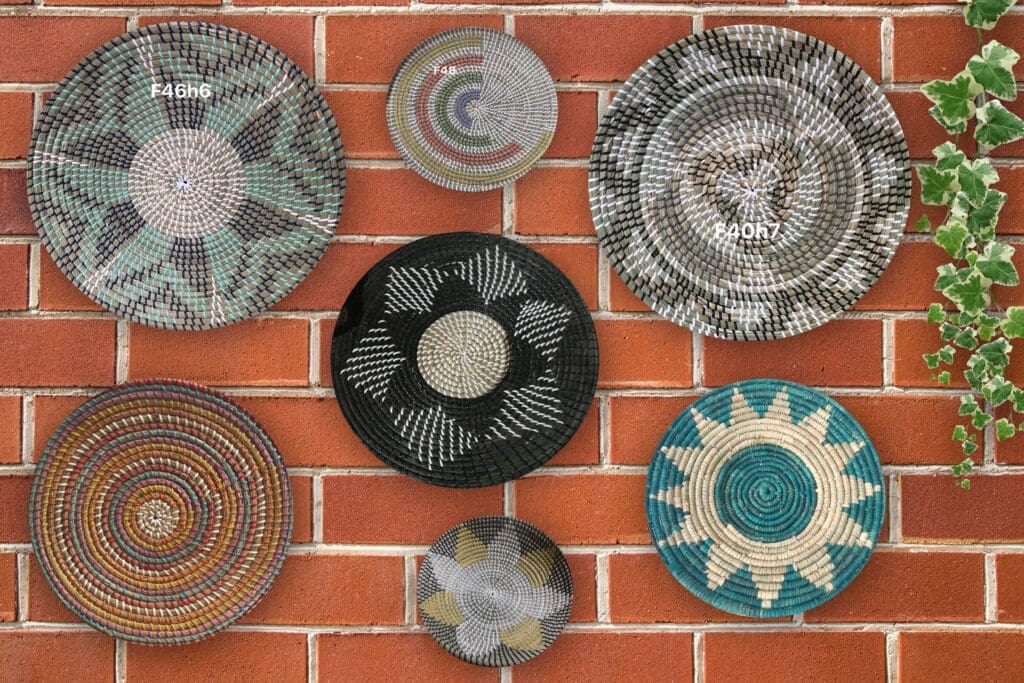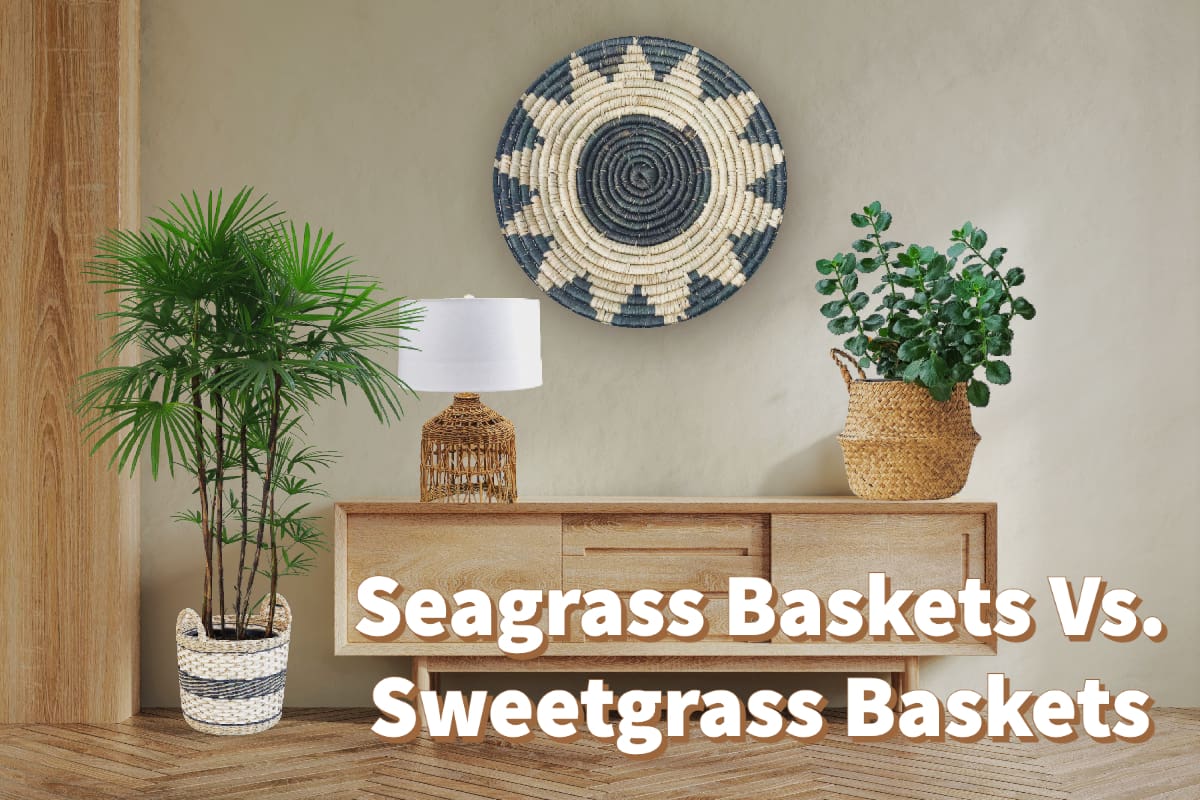Sweetgrass and Seagrass baskets are sometimes used interchangeably, but they are not the same materials. Sweetgrass and seagrass are very different materials for weaving the baskets.
Sweetgrass is a grass growing above the ground and is native to North America and Eurasia; the material is dried to be woven into baskets. Seagrass is a marine life grass that grows completely underwater in salty water shallow water areas. Seagrass is harvested, cut, and dried to hand weave baskets.
Table of Contents
- Seagrass Vs. Sweetgrass Baskets
- Understanding the Distinct Differences: Sweetgrass vs Seagrass Materials
- Related Content
Seagrass Vs. Sweetgrass Baskets
Sweetgrass and Seagrass may sound similar, but they are two different materials. They are used to weave handmade baskets but are two very different natural raw materials. They are found in various locations around the world.
Sweetgrass is a grass that is native to North America and Europe. It is grass that grows on the land and has a fragrant smell.
As the name implies, Seagrass is grass-grown entirely underwater. It is grown in many shallow waters near the ocean; Seagrass is essential for its marine life.
Both Sweetgrass and Seagrass are used to hand weave baskets, but they are both very different materials found and harvested in different parts of the world.
Understanding the Distinct Differences: Sweetgrass vs Seagrass Materials
The world of natural fibers is rich and diverse, offering a variety of materials each with its unique characteristics and uses. Sweetgrass and seagrass stand out for their distinct properties and applications. In this section, we delve into the key differences between sweetgrass and seagrass materials.
Understanding these differences is crucial for anyone working with these fibers, whether for crafting, design, or environmental purposes. From their origins and textures to their practical uses and environmental impacts, we explore the factors that set these two natural materials apart, providing valuable insights for artisans, designers, and eco-conscious consumers.
What is Sweetgrass?
Sweetgrass is also manna grass, mary grass, vanilla grass, holy grass, or bison grass. It is an aromatic herbal grass native to Eurasia and North America.
Sweetgrass is a very hardy grass known to grow in the Arctic Circle.
Many indigenous people in Canada and the United States consider it a sacred grass; Sweetgrass is used as herbal medicine or burning rites in some native cultures.
Sweetgrass also produces liquor or wine, giving the beverages a distinct smell.
Many people confuse Sweetgrass with a grass known as buffalo grass in Australia. The buffalo grass is not the same as sweet grass.
Sweetgrass Characteristics
Sweetgrass, known as Hierchloe Odorata, has leaves that will grow about 20 cm or 7.9 inches high. The leaves will also be grown outward from one planet about 100 cm or 39 inches or more.
Hierochloe Odorata is a Greek and Latin word; Hierochloe means “Holy Grass,” and Odorata means “fragrant.”
The base of the leaf below the soil surface is broad and white. The underside of the leaf is shiny.
Due to the colder climates that it grows in, it will grow mainly in the spring and summer months. The sweetgrass plants grow best in the sun or partial shade. They do not like drought conditions.
There are two strains of Sweetgrass. The regular strain can be harvested about once or twice a year. Another is the strain that grows naturally and is much faster growing; this strain can be harvested three or four times a year.
The plant is usually harvested in early or late summer. It has no scent if the grass is cut after the first frost. The lack of smell makes the grass less desirable for handweaving baskets.
The handweavers of the baskets will sun-dry out the Sweetgrass until it is dry and brittle. Then, the dried Sweetgrass will be soaked in water until pliable to be woven into baskets.
What is Seagrass?
Seagrass is the only flowering plant that will grow entirely underwater. About 60 or more seagrass species belong to different plant families.
Seagrass is used to classify many kinds of grasses that grow under the water. Seagrass thrives in salty water.
Seagrass is found in shallow, sheltered coastal waters with sand or mud bottoms. Most species will have submarine pollination and complete their life cycles entirely underwater.
Seagrass is used for basket weaving and is considered an essential plant for marine life and the sea’s ecosystems.
Many people feel that Seagrass is the unsung hero of the world’s marine life; the grass does not get all the credit it deserves. Many marine life species depend upon seagrass for their survival.
Seagrass Characteristics
On the coast of Vietnam, Seagrass is grown specifically to be cut and dried. Once dried, it can be split, twisted into rope, or woven.
The seagrass will grow back rapidly as it is a very fast-growing plant. Those harvesting and cutting the Seagrass are also very concerned about the sea and marine life.
The grass cut and grown in Vietnam is usually not harvested from the ocean floor but from the inland or more swamp areas with salty seawater in swallow patches of water.

To learn more about some of the different types of Seagrass weaves, you can read our blog by clicking this link.
Even though sweetgrass and seagrass may have similar-sounding names, they are two different materials harvested and grown in different parts of the world. Vietnam hand weaves a lot of Seagrass baskets as Seagrass is native to the coastlines of Vietnam.
If you are interested in seeing how Mondoro can help you manufacture seagrass baskets or other products – we would love to talk to you to see how we can help you.
Find out more about how Mondoro can help you create, develop, and manufacture excellent home decor and home furniture products – don’t hesitate to contact me, Anita. Check out my email by clicking here or become a part of our community and join our newsletter by clicking here.
Mondoro gives out a FREE Lookbook to anyone interested. You can receive a copy of our latest Lookbook by clicking here.
Listen to our Podcast called Mondoro Company Limited. You can find it on all major podcast platforms. Try out to listen to one of our podcasts by clicking here. Subscribe to our Mondoro Company Limited YouTube Channel filled with great videos and information by clicking here.
Related Content
Seagrass Baskets Smell, Tips To Clear Out The Odor
Over time the seagrass basket smell will almost disappear. If you cannot wait a few weeks for the smell to disappear, there are some things you can do to help the smell go away. Like most baskets woven by natural materials, seagrass baskets do well if you put them in the sun to air them out.
You can discover more by reading Seagrass Baskets Smell, Tips To Clear Out The Odor by clicking here.
5 Types of Seagrass Weaving Styles You Need to Know
A seagrass rug is a great natural addition to your home.
There are five basic seagrass weaving materials or styles used to weave all seagrass baskets and other Home Decor products. All of these use seagrass material, but the material they use can give the seagrass product a unique look and feel.
To find out more about the 5 Types of Seagrass Weaving Styles, You Need to Know by clicking this link.

